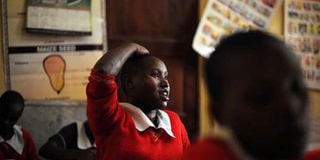Street kids struggle for survival

A picture taken on March 8, 2016 shows rescued young girls, attending a class at the Rescue-dada centre in Nairobi's low-income and densely populated district of 'Mlango-Kubwa'. PHOTO | TONY KARUMBA
What you need to know:
"It is quite difficult to describe the situation... you find if they sleep outside someone's shop, in the morning, instead of the owner waking them up gently, they kick them or even pour water on them," Moha said.
Many leave their rural areas - where traditional community ties have loosened - for cities, where they have more chance of surviving by begging, finding odd jobs, scavenging rubbish sites, or prostitution.
Abandoned by the state, several charities offer help. Alfajiri is one of them, a project set up by Australian artist Lenore Boyd, who offers drawing lessons.
Ragged, hungry and rejected by society, thousands of street children abandoned by nearly all live in Nairobi.
There is no official figure on the number of homeless children in Kenya, a sign of the lack of interest by Kenyan authorities of the problem.
One estimate, by the Consortium of Street Children (CSC), an international charity, suggests the number of street children could be as high as between 250,000 and 300,000 throughout Kenya, including 60,000 in Nairobi alone.
In the district of Mlango Kubwa in central Nairobi, a former landfill is a refuge for street children, who call it "the base".
SCRAPS FOR PROFIT
Here they sleep on the hard floor, close to the rubbish dumps where they scavenge for scraps to make some profit, but at least the place is safe from outside eyes.
A few hours after dawn, some children are still lying on the ground, the plastic bottles from which they sniff glue beside them. Other spaces are empty, with those youngsters having headed off to work, begging on the streets.
"When people see some of these kids, they do not take them as human beings," said Moha, himself a former street child, who escaped the tough life, and ekes out a living now dancing alongside bands. "When people see them sniffing glue and dirty, they beat them or insult them."
Some children are pushed onto the street following the death of parents — sometimes due to HIV/AIDS — or after running away from violence at home. Others live on the street simply because their families are too poor to look after them.
'ACT OF DESPAIR'
"It is quite difficult to describe the situation... you find if they sleep outside someone's shop, in the morning, instead of the owner waking them up gently, they kick them or even pour water on them," Moha said.
Many leave their rural areas - where traditional community ties have loosened - for cities, where they have more chance of surviving by begging, finding odd jobs, scavenging rubbish sites, or prostitution.
Abandoned by the state, several charities offer help. Alfajiri is one of them, a project set up by Australian artist Lenore Boyd, who offers drawing lessons.
"It's just to invite the kids, to get them to create. It's not to teach them, it's not to impose anything on them," Boyd said. "It's to say: 'Tell your story'. They're very focused and they do lovely work... they tell the stories in their heart and they just enjoy themselves."
When Boyd walks the streets of the slum, children throw themselves at her, finding friendship and love they otherwise lack.
"Everybody needs to think about the way they've been treated, and why they're living on the streets, and suffering on the streets," Boyd said. "These kids are traumatised, they are kids who had huge suffering, they're abandoned... going to the streets is an act of despair."
'SELLING THEIR BODIES'
Girls face an especially tough time.
The Rescue Dada Centre — 'Girl Rescue' Centre in Swahili - has been supporting the rehabilitation of street girls in Nairobi for over two decades.
Composed of a dormitory and classrooms, the centre is home to 70 girls. It offers psychological support as well as education, and leads efforts to reunite them with their families.
"The life in town is very difficult, one sleeps out in the cold where you are rained on, sometimes you find that you wake up and find that one of your colleagues has died," said Janet, 16, who just recently joined the centre. "Others even end up selling their bodies in order to get money to buy food."
Of the girls admitted in 2014, almost a third were victims of sexual abuse or sexual exploitation, some the victims of gang rape. Many are forced to become prostitutes, with a high risk of contracting AIDS.
"Rehabilitation can take a lot of time," said the centre's director Mary Njeri Gatitu. But she struggles on, providing what help she can.
"It is a drop of water in an ocean, because the issue of poverty in Kenya is not being addressed by the government," she added.





